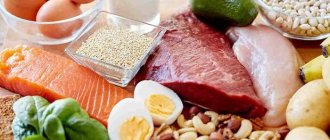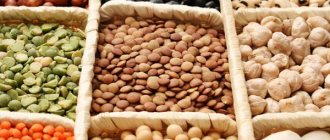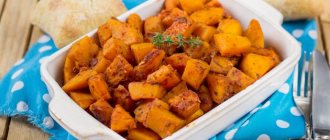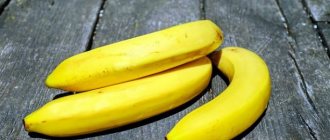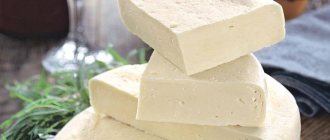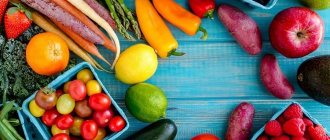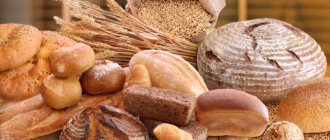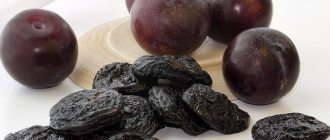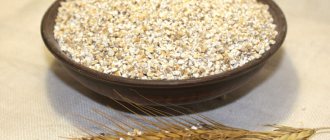The number of people with diabetes is increasing every year. The problem for these people is a lack of insulin in the blood, which is required for the normal processing of glucose. To ensure a normal quality of life for such patients, it is necessary to minimize the intake of glucose from food into the body.
Buckwheat porridge is a healthy, popular product that has long been popular. Buckwheat has many beneficial properties, but for patients with diabetes it is important whether the level of glucose in the blood increases from consuming this product. Therefore, before drawing up a patient’s menu, you need to find out the glycemic index of buckwheat - a key indicator in this case.
What is the glycemic index?
The disease affects all systems and organs, forcing a person to strictly follow restrictions.
That is why it is necessary to know what the glycemic index is, especially at the very beginning of following a diet. The rate at which the body absorbs incoming carbohydrates and the subsequent process of increasing blood sugar is called the glycemic index.
To make it easier to track the most beneficial products for humans, various tables have been created. They contain information that allows you to create the optimal menu. There is a scale with divisions from 0 to 100. The number 100 indicates the pure glucose index. Therefore, guided by the data in the tables, a person will be able to reduce this indicator.
This is necessary in order to:
- maintain optimal metabolic processes;
- regulate blood sugar levels;
- monitor the increase or decrease in case weight.
Porridges made from buckwheat or pearl barley, as well as many others, are a source of fiber, vitamins and micronutrients, but their quantity in diabetes must be strictly regulated.
Contraindications
There are few contraindications to consuming buckwheat. These include the following diseases and conditions:
- individual intolerance to the product;
- severe urolithiasis;
- peptic ulcer and gastritis in the acute stage.
The buckwheat diet as a method of losing weight is not suitable for children, adolescents, the elderly, pregnant or lactating women. An unbalanced diet can negatively affect overall well-being, health, growth and development.
How does GI affect the diabetic body?
The indicator under consideration is not a constant and unchangeable value.
The index is formed from several indicators:
- chemical composition of the product;
- method of heat treatment (cooking, stewing);
- amount of fiber;
- content of indigestible fiber.
Example: brown rice index - 50 units, peeled rice - 70 units.
This value is also influenced by factors such as:
- endemic;
- variety;
- botanical features of the species;
- ripeness.
The effect on the human body of different products is different - the higher the index, the more sugar will enter the blood during the digestion and breakdown of fiber.
An indicator equal to 0-39 units is considered safe - such cereals can be consumed in the diet with virtually no restrictions.
The average is 40-69 units, so such products should be included in the diet in limited quantities. If the indicator is 70 or higher, then such cereals can be used in the daily menu only after consultation with a specialist.
GI oatmeal and cookies
The glycemic index of any product, including oatmeal, is a floating value. The value of this parameter depends on what other ingredients are used. The method of cooking also affects. Most often, thermal exposure increases the glycemic index. This explains why raw foods have a low GI, while boiled, baked or pan-fried foods have a high GI.
Pay attention to a number of characteristics of oatmeal:
- oat variety;
- plant growing conditions;
- degree of maturity of the harvested crop;
- retrogradation of starch in the composition;
- storage duration of oats or cereals.
But these are not all the factors that influence the final value of the glycemic index of oatmeal. Thus, it is noted that when combining fats and sugar, the increase in glucose when eating a dish made from oatmeal or flour occurs faster.
Other components can also affect this indicator. This explains why oatmeal cookies have a high glycemic index of 55. Its use is limited in case of diabetes. Cookies without sugar and butter are healthier. This option is recommended for weight loss.
For comparison, oatmeal (flour made by grinding oats) has a low glycemic index of 40 units. This is due to the absence of harmful components in the composition. You can eat foods with such flour even if a person is on a diet.
We recommend that you read the Glycemic Index of Eggplant
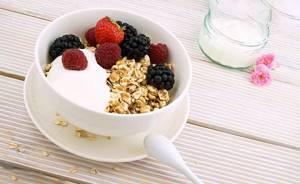
Glycemic index of main cereals
In order to create a menu suitable for a person, you should check the GI tables, because it is important to focus not only on the vitamin and mineral composition, but also on the properties of foods to raise blood glucose levels. A sharp rise in sugar can cause hyperglycemia and also cause damage to internal organs, as the load on them increases.
High GI
These cereals should be used very carefully.
Porridges made from them need to be cooked in water, as it reduces the indicator, but even then, including them in the menu is possible only with the permission of the attending physician after passing the appropriate tests.
Table of cereals with high GI values:
| White rice (polished) | 70 |
| Parboiled white rice | 60 |
| Brown rice | 55 |
| Wild rice (unhusked) | 57 |
| Brown rice | 50 |
| Millet | 70 |
| Hercules (oatmeal) | 55 |
| Millet | 71 |
| Semolina | 83 |
| Corn | 73 |
| Barley | 55 |
| Buckwheat (done) | 58 |
| Buckwheat (kernel) | 53 |
| Buckwheat (green) | 54 |
| Bulgur | 45 |
One of the types of wheat products that is classified as a product with a high index (65 units) is couscous. The composition of cereals, as well as porridge made from it, is valuable for its high level of copper. This component is necessary for the stable functioning of the musculoskeletal system, which suffers from diabetes in 90% of cases.
Consumption of this porridge allows for effective prevention of osteoporosis. Cereals are rich in vitamin B5, which normalizes the functioning of the nervous system.
Couscous, despite the large amount of useful substances, cannot be included in the daily menu of a diabetic, since the index can rise to 70 units. It is best to use plain water during the cooking process, avoid adding sugar, and do not add milk. For sweets you should use fructose or maple syrup.
Corn grits also belong to products with a high glycemic index, but at the same time, the porridge contains a large amount of various vitamins and microelements.
Table of nutrients in corn grits:
| magnesium | improves the sensitivity of tissue cells to insulin, improves the functioning of the heart and blood vessels |
| iron | improves the flow of oxygen into cells and tissues, prevents the development of anemia |
| zinc | strengthens the immune system |
| B vitamins | prevents the development of complications, strengthens the nervous system |
| beta carotene | Improves and normalizes vision |
Important! Corn grits should be consumed exclusively boiled, not fried or baked. Cornflakes, popcorn or sticks are completely excluded from the menu.
Low GI
Table of cereals that can be used in nutrition with almost no restrictions:
| Barley | 35 – 55 (depending on the cooking method) |
| Rye (grain) | 35 |
| Wild rice (peeled) | 37 |
| Whole oats | 35 |
| Quinoa | 35 |
| Amaranth | 35 |
| Lentils | 30 |
| Pearl barley | 25 |
Regular, approximately 2-3 times a week, consumption of pearl barley porridge, boiled in water , improves:
- state of the nervous and cardiovascular systems;
- hormonal background;
- hematopoiesis.
When added systemically to the diet, a person will experience improved well-being and stabilization of blood sugar levels.
Additional benefits of pearl barley:
- cleansing the body of harmful substances;
- increasing immunity;
- strengthening bones;
- improvement of the condition of the skin and mucous membranes;
- normalization of vision.
You should also remember that this cereal has a number of restrictions, so you can include it in your diet if there are no following contraindications:
- disturbances in liver function;
- frequent constipation;
- increased stomach acidity.
It is better not to use pearl barley porridge as a dinner. To improve the taste, you can add a hard-boiled egg to the porridge.
Features of application
Buckwheat porridge can be present in the diet every day, the main thing is at least 2-3 times a week.

In the diet for various diseases
Buckwheat is recommended for people with impaired liver and kidney function to improve blood flow in the liver vessels, prevent bile stagnation, cleanse toxins, restore the structure and function of organs. For 10 days, eat 1-2 tbsp of buckwheat steamed overnight for breakfast. l. with the addition of vegetable oil. After eating, do not drink or eat for 2-3 hours. Then they take a break and repeat the treatment after 10 days. The full course consists of three approaches.
Buckwheat is useful for diseases of the pancreas and digestive system. It acts as an anti-inflammatory, wound-healing, enveloping agent, and alleviates the severity of symptoms. Taking into account the characteristics of the disease, patients are offered buckwheat porridge in crumbly, semi-liquid or ground form.
Buckwheat porridge helps prevent hyperkalemia and possible complications associated with diabetes. To do this, systematically consume steamed buckwheat in combination with foods rich in proteins and fiber.
Buckwheat steamed overnight helps to improve the process of bowel movement and improve the health of people with diseases of the musculoskeletal system (rheumatism, gout, osteochondrosis). Steamed buckwheat porridge should be included in the menu of patients with arterial hypertension and those prone to high blood pressure.
For weight loss
Due to the widespread popularity of buckwheat for weight loss, there are a variety of dietary regimens based on it. Based on the desired result and the body’s capabilities, the optimal option for duration and diet is selected.
Fasting day
Nutrition consists of eating 250 g of steamed buckwheat throughout the day. The prepared porridge is divided into 5-6 meals at equal intervals of 2-3 hours. At the same time, drink a lot of water, green tea without sugar, and still mineral water.
This diet allows you to maintain a given weight or return to normal after a period of prolonged overeating. On average, from 0.5 to 1 kg of weight is lost per day, mainly due to the removal of excess fluid, waste and toxins from the body.
Buckwheat mono-diet for three days
The classic version of the diet combines adequate effectiveness with minimal health risks. The diet for one day consists of 250 g of buckwheat, steamed overnight with boiling water in a ratio of 1:2 without spices, oil, or sauces. The prepared porridge is divided into 5-6 equal portions. In between meals, drink water or green tea, freshly squeezed vegetable/fruit juice. If you feel a pronounced feeling of hunger, you can allow yourself a small portion of fresh or steamed vegetables, fruits, and dried fruits as a snack. Three days of strict nutrition will take away from 1.5 to 3 kg of weight.
Buckwheat diet for 5 days
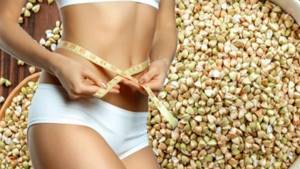
Involves eating two foodstuffs: egg grains and low-fat kefir. Buckwheat is poured with kefir overnight and divided into 5 equal portions in the morning. Drinking regimen - 1.5-2.5 liters of water per day. With strict adherence to your diet, you can get rid of 2-4 extra pounds.
Buckwheat diet for 7 days
The basis of the diet is buckwheat steamed or cooked without salt and oil. Only minimal quantities of olive oil, natural soy sauce, and low-calorie yogurt/kefir are allowed. The porridge is supplemented with fresh vegetables and garden herbs. As a snack, you can have some fruits (except grapes and bananas) and dried fruits. The weight loss result varies between 5-7 kg.
Buckwheat diet for 14 days
The safest and most gentle dietary option. The bottom line is to eat boiled/steamed buckwheat with other products from the list of permitted ones. These include vegetables, fruits, berries, low-fat dairy and fermented milk products, lean meat and fish, rye bread, cheese, and eggs. Drink at least 1.5 liters of clean water every day. Weight loss rates fluctuate around 6-8 kg, with regular physical activity - 8-10 kg.
Sample weekly menu for diabetes
The only exceptions are those products that, in addition to their effect on carbohydrate metabolism, have good healing properties in the treatment of diabetes complications. At the same time, it is advisable to reduce the overall glycemic index of the diet at the expense of other, less important foods. After all, diabetes is not a disease of one day, but of a lifetime. You need to be able to adapt to it, primarily through the correct selection of dietary nutrition.
Some people panic when they hear a doctor’s diagnosis of diabetes: what they can eat and what they can’t. In the case of diabetes, especially type 2, this should not be disputed at all.
Options for using oats
This product is somewhat universal when it comes to preparing various dishes. Oats for diabetes can be eaten in different forms and here are some of them:
- porridge – do not confuse “Hercules” and pure oats, which can also be bought in most supermarkets. It is sold in beans and brewed for several hours. If this is too time-consuming for you, you can pre-soak the oats in cold water until the oats soften. And then it’s enough to grind the resulting slurry in a blender so that it acquires the structure of a completely homogeneous mass;
- bars - you can buy ready-made ones or make them yourself at home. It is necessary to follow the processing process correctly in order to ultimately get what is required. A couple of these bars are quite capable of replacing a full bowl of oatmeal. They are convenient because you can take them with you, and they are stored for a long time. The recipe for making such a delicacy is not difficult to find very easily on the relevant Internet resources;
- muesli – ready-to-eat steamed oat flakes. They do not require long cooking - just pour kefir, yogurt, warm water or milk over them, leaving for 10-15 minutes;
- sprouted - in order to start consuming it, you need to first soak the crop in water until sprouts appear. It is these that you then need to eat or drink, blending them in a blender with water;
- jelly - combined with kefir or other liquid dairy products. The classic version of the drink is less like a decoction that you can drink and is more likely associated with an independent dish. If you don’t have time to tinker with oatmeal jelly for a long time, just brew 2 tsp. crushed culture, and then sweeten with a couple of spoons of berries or jam. It turns out very satisfying and healthy;
- infusion – 1 tbsp. Rinse the oats with cold water, and then pour 1 liter of boiled water, tightly close the lid of the container with the infusion and keep in a dark place at room temperature for at least 12 hours. It is best to start before bed and drink it in the morning (it can be used in three doses during the day, but in the evening you need to make a new tincture). Always be sure to strain the infusion before using it. You should use the infusion as a treatment for diabetes for no more than 3 months, and then take a break for one.
